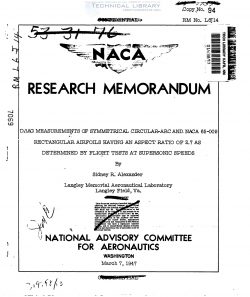naca-rm-l6j14
- Version
- 57 Downloads
- 406.11 KB File Size
- 1 File Count
- April 24, 2017 Create Date
- April 24, 2017 Last Updated
National Advisory Committee for Aeronautics, Research Memorandum - Drag Measurements of Symmetrical Circular-Arc and NACA 65-009 Rectangular Airfoils Having an Aspect Ratio of 2.7 as Determined by Flight Tests at Supersonic Speeds

Flight tests have been conducted at supersonic speeds to
determine the drag characteristics at zero lift of a wing having a
circular-arc airfoil section with a maximum thickness of 9 percent
chord. The wing plan form was rectangular and had an aspect ratio
of 2.7. Included for comparison are results of similar tests
previously conducted on an RAGA 65 -009 airfoil. For the Mach number
range investigated (0.85 to 1.22), the NACA 65-009 airfoil produced
lower values of drag coefficient than the circular-arc airfoil. The
difference in drag coefficients of the two airfoils was greatest
at Mach numbers near 1.0.
The possibility of practical flight at supersonic speeds has
led to the study of-airfoil shapes that differ. basically in profile
from conventional round-nose types~ Comparisons of the character-
istics of round-nose and sharp-nose airfoil sections at subsonic
and supersonic speeds, respectively, have been reported. in refer-
ences l and 2- Ho theoretical data and only extremely meager
experimental data on this general subject, however, are available
for the transonic speed range (the region of ruined flow) - Tests
have therefore been conducted at the test station of the Langley
Pilotless Aircraft Research Division at Wallops Island, Va-, to
determine the zero-lift drag of a rectangular, 9-percent circular-
erc airfoil of aspect ratio 2.7 mounted "on a rocket-propelled body.
This value of aspect ratio is ”eased on the total wing span and area
including the part enclosed. by the body- For comparison, the
results of tests of the rectangular NASA 65-009 airfoil, which
has the same aspect ratio, presented in reference 3 are included.
A photograph of the test body is shown as figure 1. The body
was approximately 5 feet long and 5 inches in diameter and was of
wooden construction The 9‘percent cirbular-arc airfoil of 25 73 -inch
span, was mounted on the body so as to have the quarter-chord point
at t}.e same longitudinal station as the design center of gravity The
airfoil had neither taper, twist, nor dihedral The leading and
trailing edges were rounded off to a EE-inch radius w'nich was
about 30 percent of the leading-edge radius of the NADA ES-series
airfoil section. Except for airfoil section, the test body with the
circular-arc airfoil and the comparable test body with the
NAflA 65~o09 airfoil of reference 3 tare alike.
| File | Action |
|---|---|
| naca-rm-l6j14 Drag Measurements of Symmetrical Circular-Arc and NACA 65-009 Rectangular Airfoils Having an Aspect Ratio of 2.7 as Determined by Flight Tests at Supersonic Speeds.pdf | Download |

Comment On This Post